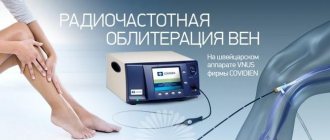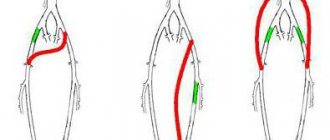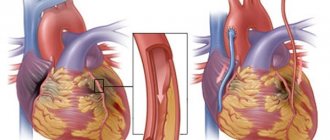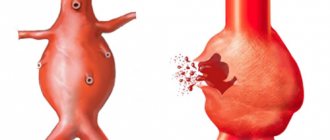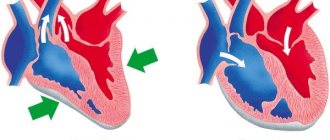Ablation is a method of minimally invasive treatment of heart rhythm disorders, the technique has clear indications, mainly related to unstable, unstable beating of the muscular organ. For example, diagnoses include tachycardia caused by excessive stimulation of the chambers, etc.
There can be many options. The procedure is generally quite safe and has a minimum of contraindications. The effect is observed in more than 80% of patients. Other cases are associated with incorrect diagnosis or incorrect execution technique.
Unlike surgery, ablation does not require long recovery. After a day or even earlier, the patient can go home.
Restrictions during the rehabilitation period are minimal: do not carry heavy objects, do not engage in intense physical activity, etc. But there are a lot of nuances that need to be taken into account.
The essence of the method and what problems it solves
The event is based on the effect of electric current on the heart. To be more specific.
Diseases that provoke arrhythmias mainly affect in several ways.
- The first is the excessive production of a bioelectric impulse. As a rule, this is a congenital feature. This can only be called a pathology conditionally. However, it creates huge problems.
Excessive activity of the sinus node leads to the fact that the muscular organ begins to contract more often. The natural pacemaker is also susceptible to provoking factors.
That is, a small amount of physical activity is enough for the heart to work many times more actively than it should. In this case, ablation is carried out to reduce the activity of generating a bioelectric impulse.
There is another extreme. For example, if there is a blockade of the conduction system in any area. Other cardiomyocytes (heart cells) also begin to produce a bioelectric impulse.
Normally this cannot happen. Since synthesis is carried out by the natural pacemaker - the sinus node. It is located in the right atrium.
In this same anomalous case, complete chaos is observed. All cameras shrink at their own pace. This is the so-called fibrillation. If you do nothing, cardiac arrest is very likely.
- The second is the impact of a pulse of normal intensity. But provided that there are additional conducting bundles (WPW syndrome).
In this case, the bioelectric signal is synthesized as it should. However, because additional pathways are present, they propagate the signal beyond the normal anatomical location.
The task of doctors in this case is to eliminate unnecessary bundles. This is the essence of ablation.
A minimally invasive procedure, RFA of the heart is a method by which doctors cauterize and destroy abnormal micro-areas of the muscular organ.
Specialists face several tasks:
- Restoring normal rhythm. Depending on which pathological process prevails, the method of correction will be different. For example, cauterizing individual clusters of cardiomyocytes (heart cells) to prevent fibrillation. Or the destruction of the congenital excess vascular bundle. There are several options.
- Prevention of relapse of the pathological process. Thanks to ablation, the risk of recurrence of the disorder can be reduced to zero. Because the main culprit will be destroyed.
- Return to normal exercise tolerance. Decreased tolerance to mechanical activity is a typical symptom of heart disease. A patient in advanced stages cannot climb stairs or walk a hundred meters without shortness of breath.
If the cause is eliminated, the heart rhythm will also return to adequate values. The person will be able to engage in normal activities without any special restrictions. Provided that irreversible changes have not yet formed and treatment arrives on time.
- Restoring the patient's general normal state of health. Return to a healthy life. Although, you often have to take maintenance medications. Cardioprotectors like Mildronate or Riboxin. If not constantly, then at least in courses.
The essence of therapy is to eliminate areas of abnormal electrical activity. With sufficient qualifications of the doctor, it is possible to solve the problem once and for all.
Arrhythmia after eating: why does eating provoke an arrhythmic heart rate?
Currently, the number of patients complaining of irregular heartbeat or chest discomfort is constantly increasing.
For example, after a heavy holiday meal, a person may suddenly experience shortness of breath or a loud heartbeat in the ears. Arrhythmia after eating does not always cause such unpleasant sensations. Sometimes it may not bother a person, but in other cases it is very difficult to get rid of it within a few hours. There are people who, due to arrhythmic disorders, lose consciousness or experience symptoms that are characteristic of food poisoning.
Elderly patients and those who suffer from chronic heart disease are most prone to developing arrhythmia after eating. Also, heart rate disorders occur in people who are overweight and have serious gastrointestinal problems.
Why do arrhythmic contractions occur after eating? It is important to know that the intensity of the heartbeat depends on the general condition of the body. If impulses are conducted normally and the cells are saturated with oxygen, then the heart will work at an adequate frequency - no more than 90 beats per minute.
But eating increases the response of the vagus nerve, which can inhibit the sinus node, where the impulses necessary for heart contractions are formed. In addition, excessive consumption of foods leads to pressure on the diaphragm, which in turn increases breathing speed and reduces the supply of oxygen in the body.
Indications
There are several reasons for cardiac ablation. Conventionally, we can talk about three classes. They are divided by priority. If we name the indications from the most important to the least important, the list will be like this.
First grade
Atrioventricular or paroxysmal tachycardia.
The AV node is located in the central region of the heart. It is responsible for redistributing the incoming electrical signal. Prevents the ventricles from contracting until the process is completed in the atria.
Then it transports the impulse further. It does not produce a signal itself. However, against the background of the named pathological process, the opposite is true.
A section of additional contraction is formed. The atrioventricular node itself begins to work as a pacemaker. This is extremely dangerous and leads to a significant increase in heart rate. Up to 180 beats per minute or more.
During an attack, cardiac arrest and death of the patient are possible. As a rule, not the entire node is involved, but part of it. Through catheter ablation, doctors cauterize the abnormal anatomical area.
Read more about paroxysmal tachycardia in this article.
Wolff-Parkinson-White syndrome.
Or WPW syndrome. A relatively rare pathological process. According to various estimates, it occurs in less than 0.1-2% of patients worldwide. The essence of the disorder is roughly described above.
Additional conductive bundles pass to the ventricles. They act as independent transport pathways, go around the atrioventricular node and go directly to the chambers of the muscular organ.
Consequently, the normal contractile order is reversed. The ventricles begin to work before the atria perform their function. It is not normal.
Auxiliary bundles are cauterized.
Atrial flutter or fibrillation.
Accompanied by a spontaneous increase in electrical activity of the supraventricular structures of the muscular organ. They begin to contract chaotically. This shouldn't happen.
Specialists artificially stimulate areas of the heart, causing abnormal functioning. Thus, the culprits of the problem are discovered. Then all that remains is to eliminate them and restore normal rhythm.
Atrial flutter is described in detail in this article, and fibrillation in this one.
The three named pathologies are the main indications for urgent therapy. Apart from RFA (radiofrequency ablation) surgery, there are no other options to restore normal heartbeat. There are also less specific reasons for such treatment.
Second class
Ineffectiveness of antiarrhythmic drugs against the background of atrial flutter.
Sometimes, before prescribing a specific correction, specialists resort to drug treatment. Special drugs like Amiodarone or Quinidine are used.
If pharmaceuticals do not help eliminate the pathological process, it makes sense to perform ablation.
Ventricular extrasystole.
The essence is approximately the same. From time to time, cardiac structures begin to create an impulse on their own. At these moments, extra, extraordinary blows slip through. They are felt as revolutions, sharp contractions of a muscle organ.
This is a dangerous condition, but it is treated primarily with drugs. Radiofrequency ablation of the heart to eliminate extrasystoles is prescribed only if drug therapy is ineffective. As a second line measure.
Sustained tachycardia.
Usually, it takes several weeks of persistent examination to identify the cause. As a rule, it’s all due to extra foci of excitation. This problem can only be solved invasively. Tablets are useless and only temporarily relieve symptoms.
Third class
There are indications that do not require mandatory surgery. The issue is decided by doctors taking into account the opinions of patients.
Ventricular tachycardia is the main basis of this subgroup. She is being treated with medication. Only if ineffective is ablation prescribed.
There are many indications. But RFA is not done thoughtlessly. Therefore, before undergoing the procedure, the patient is sent for additional examinations.
Contraindications
There are not many reasons to refuse radiofrequency ablation.
Heart failure in the decompensation phase
Because the cardiac structures are the ones that are subject to intervention. It is possible for the organ to stop working and the patient to die from complications. Until the condition is brought back to normal, it is not compensated, it is strictly prohibited to prescribe and perform an operation.
Signs of heart failure in women are described in detail here, and in men here.
Kidney diseases in severe phase
For example, nephropathy, with dysfunctional failure. The problem is that all such conditions end with a rapid increase in blood pressure. Thus, the heart is under attack.
Interventions for uncorrected renal pathologies are prohibited.
Myocardial infarction and several days after it
Until the affected area is completely scarred. It is advisable to wait a few weeks, or even months. Provided that such a prolonged waiting period does not lead to dangerous complications.
The question is decided by the doctor on the spot. After a thorough assessment of the patient's condition. The degree and speed of recovery from a heart attack.
Electrolytic problems
Lack of potassium, calcium, magnesium or sodium. So does excess. Pathologies of this kind often provoke rhythm disturbances. Therefore, it is easy to confuse where the organic problems are and where there is a deficiency of electrolytes or the reverse process.
Until it becomes clear what is what, the operation is postponed. Moreover, if there is an imbalance of water-salt metabolism, ablation is useless and even critically dangerous.
Acute infections
Regardless of localization. During the period when the body is fighting viruses and bacteria, surgery cannot be performed. Because there is a high risk of complications, including cardiac arrest.
You need to wait for the body to fully recover from the pathology and only then treat the heart.
Contrast agent intolerance
Ablation is performed using catheterization. That is, the electrode is moved to the cardiac structures. To monitor the progress of the instrument from the artery to the myocardium, a special scanner is used.
Contrasting compound improves visibility. But you may be allergic to these drugs. Therefore, before the appointment, the patient is carefully questioned about drug intolerance.
Tests are carried out with contrast to exclude a reaction “in the field” conditions.
Coagulopathies
In other words, blood clotting disorders.
Arterial hypertension
An increase in pressure above 140 to 90 mmHg. This is a reason to postpone surgery until the condition returns to normal. You may need to take medications.
Some heart defects
For example, narrowing of the mitral valve. The question is open. It is decided by cardiologists and specialized surgeons.
Radiofrequency ablation of the heart is a safe procedure, but only if all contraindications are followed. The outcome and rehabilitation period depend on this. Its duration, severity.
Arrhythmia after smoking: how are they connected?
According to statistics, it can be understood that the majority of patients suffering from heart attack/angina are experienced smokers. IHD occurs as a result of a decrease in the patency of blood vessels and the supply of oxygen to all cells of the body. It has been proven that people who smoke are 2 times more likely to have a heart attack. And with high cholesterol levels in their blood, this risk increases up to 10 times.
Why does arrhythmia occur after smoking? The heart muscle can function fully only in cases where the coronary arteries supply blood normally. But in smokers, the blood vessels wear out very quickly, which leads to oxygen starvation of the heart fibers. In addition, immediately after inhaling tobacco smoke, a person’s heart rate increases, blood pressure rises, and blood vessels constrict. After this, the heart begins to pump blood with increased stress, causing its rhythm to become disrupted.
It was found that women who smoke have a higher risk of developing heart pathologies than men. This is due to the fact that the female body is more susceptible to the effects of nicotine. Once an arrhythmia develops, a person's heart may suddenly stop. Therefore, active and passive smokers are recommended to quit the bad habit even before pathological changes appear.
Preparation
Doesn't present any particular difficulties:
- Echocardiography is performed. This technique allows you to examine the organic position of the heart. His anatomical state. Detects all structural changes.
- An ECG is also required. Unlike the previous technique, it shows functional deviations. Both methods are assigned in the system.
- General blood test and biochemistry. To identify possible inflammatory, infectious or autoimmune processes. Which are contraindications.
- Also coagulogram. Blood clotting study. Since grounds for refusing the procedure are also possible in these cases.
Additional measures are also prescribed. Alternatively, a chest x-ray or ultrasound of the internal organs. Urine examination. It is better to clarify this point with your doctor. Next, the actual preparation begins.
- 12 hours before the procedure, refuse food and water. This will reduce the intensity of discomfort and increase tolerance to ablation.
- Stop smoking and drinking alcohol within 24-48 hours. They cause a narrowing of the lumen of blood vessels, an increase in blood pressure. Doctors are unlikely to get to work if the patient is in this condition.
- You should consult your doctor about medications. When a patient takes medications such as antihypertensives or antiarrhythmics, you need to discuss this with a specialist. It may make sense to stop taking some medications. But by no means alone.
- Notify doctors on site about the installed pacemaker. If one is implanted.
Otherwise, all you have to do is arrive at the place at the appointed time.
Progress of the operation
The patient lies down on the couch.
- The area of the femoral, radial artery or other access sites is treated with an anesthetic. Nothing more is required.
- A contrast agent is then injected for better visibility.
- The specialist conducts an EFI. The heart is stimulated using electrodes through the esophagus or through invasive access. A small current is passed through different areas. This is necessary to determine the exact location of the anomaly. There are cases when there are several such areas. This means that they all need to be processed.
- Then, after EPI has been performed, the actual radiofrequency operation begins. The electrode is connected to a special device. Abnormal areas are cauterized using current. This is done gradually and under the full control of the apparatus. The data is visualized and displayed on the screen.
- After the RFA operation is completed, the doctor repeats the EPI, stimulates the heart and looks at the response of the organ. Normally, it should be minimal. In response to the correct conduction of an electrical impulse, the entire heart contracts, not individual chambers.
During the procedure, there may be a feeling of inversion and heart fluttering. It's quite normal. Any discomfort should be reported to a cardiologist or surgeon immediately.
Arrhythmia after a stroke: why is it dangerous?
If a person has had a hemorrhagic or ischemic stroke, then severe arrhythmic heartbeat disturbances can provoke a second stroke. Despite strict treatment during the rehabilitation period, patients are still not immune from complications of the cardiovascular system.
If the arrhythmia after a stroke is severe, then patients are recommended to undergo surgery to implant a pacemaker. Using this device can reduce the risk of developing an irregular heartbeat or cardiac arrest.
But before making a decision before surgery, you need to take into account the patient’s age, concomitant diseases, and the likelihood of a favorable transfer of general anesthesia. If there are no contraindications, after drug treatment without a positive result, it is recommended to install a pacemaker that protects the patient from a recurrent stroke.
Rehabilitation
The recovery period lasts about a week. For the first day or two, a person is in a hospital setting. For specialists to look after the post-operative patient. They assessed the condition and helped if necessary.
- You need to lie down for 3-4 hours. So that the heart is rebuilt in a new way, and so that wounds in the area of catheter access do not open.
- Once the person is discharged, they can return to their normal lives. But the restrictions apply to physical activity. You cannot run, jump, or carry weights exceeding 10 kg. You will have to follow a gentle regime for a week.
- Accordingly, no temperature changes or the influence of severe cold/heat. Baths and long hot baths are contraindicated.
After about 7 days you need to see a specialist. Then, with his permission, you can return to normal life.
Arrhythmia after physical activity: is this possible?
All experts say that playing sports is part of a healthy lifestyle and especially helps the cardiovascular system work. But in some cases, exercise has the opposite effect and causes heart rhythm disturbances. Why?
British cardiologists have discovered that high loads provoke changes in heart cells at the molecular level, which are responsible for generating its contractions. This explains why athletes who engage in intense exercise throughout their lives develop a slow heart rate. It is in these people that the risk of arrhythmia increases with age.
To prevent arrhythmia from developing after physical activity, doctors recommend training endurance according to the following scheme:
- Do not engage in anaerobic exercise for more than 2.5 hours per week.
- Distribute the loads for each day so that they are uniform and not spasmodic.
- If a person runs, then he should rest after the peak of intense overload of the body, thus the heart has time to rest from tension.
- Before vigorous physical activity, it is important to warm up the muscles, gradually increasing the strength of the load.
But even if an athlete is at risk of developing arrhythmic contractions, doctors say that the benefits of exercise outweigh it.
Possible consequences
Complications occur in 1-2% of cases. There is evidence of higher or lower rates.
Possible consequences of RFA include:
- Damage to nerve endings. Rare case. Only if the doctor is not qualified enough.
- Lesions of the esophagus. Lead to unpleasant sensations in the throat and stomach. Bleeding is likely.
- Pain at the catheter access site.
- Thromboembolism is a complication after RFA on the heart if the vessels have been damaged.
- Death is also possible. But this is an extremely rare complication. It occurs only in patients for whom endovascular ablation is fundamentally contraindicated. If for any reason the basis for refusal has not been taken into account, the possibility of death exists.
RFA in cardiology is an indispensable method for treating arrhythmias. True, not everyone. The technique is 100% safe, there are risks, although not large. The question of the appropriateness of such a procedure is decided by the doctor.
